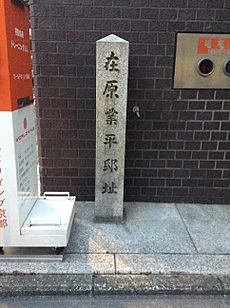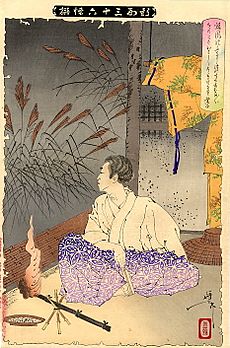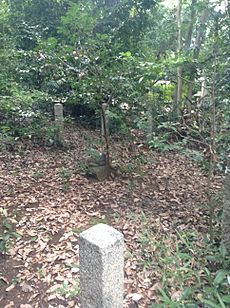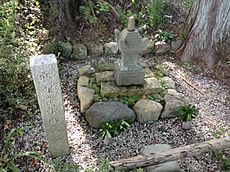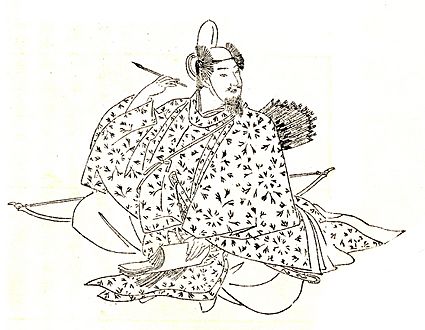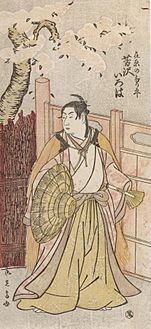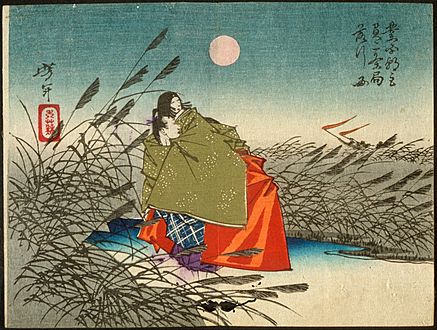Ariwara no Narihira facts for kids
Quick facts for kids
Ariwara no Narihira
|
|
|---|---|
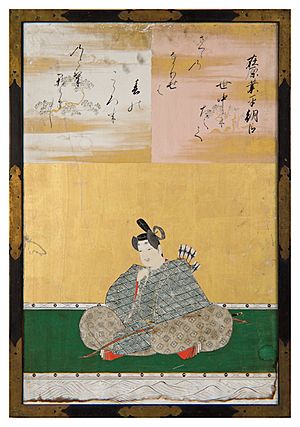
Ariwara no Narihira by Kanō Tan'yū, 1648.
|
|
| Native name |
在原業平
|
| Born | 825 |
| Died | 9 July 880 (aged 54–55) |
| Language | Early Middle Japanese |
| Period | early Heian |
| Genre | waka |
| Subject | nature, romantic love |
| Spouse | unknown |
| Children |
|
| Relatives |
|
Ariwara no Narihira (在原 業平, 825 – 9 July 880) was a famous Japanese courtier and waka poet. He lived during the early Heian period (794-1185).
He is known as one of the Six Poetic Geniuses and one of the Thirty-Six Poetic Geniuses. One of his poems is even in the famous Ogura Hyakunin Isshu collection. People also knew him by nicknames like Zai Go-Chūjō or Mukashi-Otoko.
Narihira's poems are often deep and can have many meanings. Because of this, the people who put together the Kokin Wakashū poetry collection in the 10th century wrote long notes to explain his poems. There are 87 poems in court collections that are said to be by Narihira, but some might have been written by others.
Contents
About Ariwara no Narihira
His Early Life and Family
Ariwara no Narihira was born in 825. He had a very important family background. Both of his grandfathers were emperors! His father, Prince Abo, was the son of Emperor Heizei. His mother, Princess Ito, was the daughter of Emperor Kanmu.
Narihira was the fifth child of Prince Abo. He was the only child of Princess Ito, who lived in a place called Nagaoka. Some of Narihira's poems even talk about his mother.
When Narihira was young, his father, Prince Abo, had to leave the old capital city of Heijō (now Nara) for a short time in 824. This was because of some political trouble. Narihira was born while his father was away. After his father returned in 826, Narihira and his brothers, including Yukihira, became commoners. They were given the family name Ariwara.
His Work at Court
Even though we remember Narihira mostly for his amazing poetry, he came from a high-ranking family. He worked for the emperor's court for many years.
In 841, he started as a Lieutenant in the Palace Guards. Over time, he moved up to higher positions. He became a Chamberlain and held various roles in the military guards. He also served as a Provisional Governor for different provinces like Sagami and Mino. By the end of his life, he had reached the Junior Fourth Rank, Upper Grade. This shows he was an important person in the court.
His Journey to the East
Some old stories, like the Kokinshū and Tales of Ise, say that Narihira left Kyoto and traveled east. He went through the Tōkaidō area and crossed the Sumida River. Along the way, he wrote poems about famous places. These poems are called utamakura.
The Tales of Ise suggests this trip happened because of a difficult personal situation Narihira was in. However, some historians wonder if he really made such a long journey. It would have been unusual for a court official to travel so far with only a few friends. Also, there are not many poems from this trip that have survived.
His Passing
Ariwara no Narihira passed away on July 9, 880. His very last poem, found in the Kokinshū (poem 861), shows his surprise and sadness that his life was ending so soon.
| Japanese text つひにゆく |
Romanized Japanese tsui ni yuku |
English translation Long ago I heard |
This poem tells us that Narihira knew everyone must die someday. But he was still shocked that his time had come so quickly, even though he was in his fifties.
Where He Might Be Buried
No one is completely sure where Narihira is buried. In the past, some people even thought he was a god or a special form of the Buddha. So, some places called his "graves" might actually be holy sites dedicated to him.
One place thought to be his burial spot is a small stone area on Mount Yoshida in Kyoto. This site might have become linked to Narihira because it was near the grave of Emperor Yōzei. In the Middle Ages, some people believed Narihira was connected to the birth of Emperor Yōzei. Another place believed to be his grave is Jūrin-ji temple in western Kyoto, which is also known as "Narihira Temple."
His Family After Him
Narihira had children who also became waka poets, like Muneyana and Shigeharu. He also had at least one daughter. Through his son Muneyama, he was the grandfather of another poet, Ariwara no Motokata. One of his granddaughters married Fujiwara no Kunitsune.
His Different Names
Narihira was known by a few nicknames. These include Zai Go-Chūjō (在五中将), Zai Go (在五), and Zai Chūjō (在中将). The "Zai" comes from the first part of his family name, Ariwara. "Go" means "five" in Japanese, referring to him and his four brothers. "Chūjō" means "Middle Captain," which was a high position he held in the palace guards.
He was also called Mukashi-Otoko (昔男), which means "Man of Long Ago." This name became popular because it was used often in The Tales of Ise.
His Poetry Style
Narihira wrote many poems, and 30 of them were included in the important Kokinshū collection from the early 10th century. Many more appeared in later collections, but it's not always certain he wrote all of them.
Ki no Tsurayuki, a famous poet, mentioned Narihira in the introduction to the Kokinshū. He called Narihira one of the Six Poetic Geniuses, who were very important poets from an earlier time. Narihira was also later included in Fujiwara no Kintō's list of the Thirty-Six Poetic Geniuses.
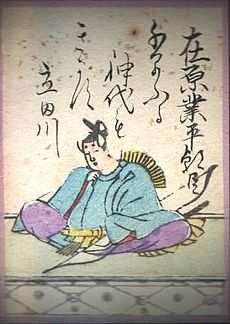
Here is one of Narihira's most famous poems. It is poem number 17 in Fujiwara no Teika's Ogura Hyakunin Isshu:
| Japanese text ちはやぶる |
Romanized Japanese Chihayaburu |
English translation Even the almighty |
This poem is very well-known, especially because it appears often in the manga and anime series Chihayafuru. In the story, the main character, Chihaya Ayase, uses this poem as her "name card" in the game of karuta.
How He Wrote Poems
Scholars have studied Narihira's poems in the Kokinshū to understand his unique style. He often used two special techniques: engo (related words) and kakekotoba (pivot words).
Engo are words that are related in meaning, even if they are not used together in a normal sentence. For example, in poem 618 from the Kokinshū, Narihira uses several words related to water:
| Japanese text つれづれの |
Romanized Japanese tsurezure no |
English translation Lost in idle brooding. |
Here, "brooding" (nagame) sounds like "long rain" (naga-ame). Then there's "river of tears" (namidagawa) and "is soaked" (nurete). All these words create a feeling of sadness and water.
Narihira's poems were often quite mysterious, which is why the Kokinshū compilers added long notes to explain them. He was the only poet in that collection to get such detailed explanations. His most famous poem, Kokinshū No. 747, is a good example of his mysterious style:
| Japanese text 月やあらぬ |
Romanized Japanese tsuki ya aranu |
English translation Is that not the moon? |
This poem has been understood in different ways over the centuries. Some think he's asking if the moon and spring are different, even though he himself hasn't changed. Others think he's saying the moon and spring are different, and only he remains the same. This shows how deep and thought-provoking his poetry can be.
His Link to The Tales of Ise
The Tales of Ise is a famous collection of stories and poems. It focuses on a main character who is believed to be based on Ariwara no Narihira. The book tells different episodes from this character's life and includes poems he supposedly wrote, along with stories about what inspired them.
For a long time, many people thought Narihira himself wrote The Tales of Ise. However, most scholars today don't believe he was the author. It's possible that Narihira might have started writing down some of his poems and life stories, and then someone else later added to it after he passed away. The book likely took its current shape around the middle of the 10th century, several decades after Narihira's death.
Scholars think the book was put together in three main steps. The first part probably used real poems by Narihira, but the stories around them might not have been entirely true. In the second step, more poems were added, some of which might not have been by Narihira, and the stories became even more fictional. In the final step, a later writer added Narihira's name and made him seem like a legendary figure from the past.
His Impact on Japanese Culture
Narihira, along with his contemporary Ono no Komachi, became symbols of beauty and elegance in the Heian court. They often appear in later Japanese plays, especially in Noh theatre.
Many believe that Narihira was one of the inspirations for Hikaru Genji, the main character in The Tale of Genji, a very famous Japanese novel written by Murasaki Shikibu. The Tale of Genji even mentions The Tales of Ise and draws connections between its own hero and Narihira.
Narihira also appears in other old Japanese tales, like those in the Konjaku Monogatarishū from the late Heian period. During the Edo period, he was a popular subject in ukiyo-e woodblock prints and was mentioned in books by writers like Ihara Saikaku.
Even a warrior from the 16th century, Ōtomo Yoshiaki, used Narihira in a poem. He wrote it about an enemy he defeated, comparing him to Narihira, the "man of long ago."
| Japanese text 立花は |
Romanized Japanese Tachibana wa |
English translation Tachibana has |
Gallery
- Ariwara no Narihira image gallery
-
Drawing of Narihira by Kikuchi Yōsai.
-
Narihira and Nijō no Tsubone at the Fuji River, woodblock print by Yoshitoshi, 1882
See also
 In Spanish: Ariwara no Narihira para niños
In Spanish: Ariwara no Narihira para niños


